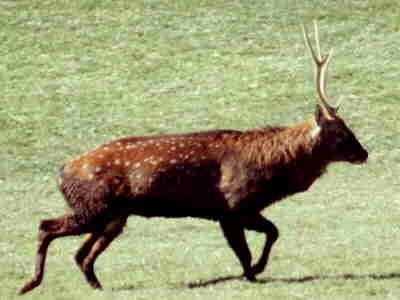 SKC Films Library SKC Films Library |
| SKC Films Library >> Science >> Zoology >> Mammals >> Order Artiodactyla >> Family Cervidae |
| Sika Deer [sE' ka] Cervus nippon Description The sika deer is a medium-sized deer, standing 25 to 48 inches high at the shoulder, with a length of 59 to 74 inches and weighing 132 to 310 pounds; males are significantly larger than females.
Coat color ranges from grayish or chestnut brown to reddish brown, with males developing characteristic white spots in the summer. The tail, which is 4 to 8 inches long, is primarily white, with a wide black stripe above, and males have white hairs on the rump which stand erect during the rut. Males typically have four-pointed antlers that reach a length of up to 2.7 feet before being shed in April or May. Distribution and Habitat Native to East China, Taiwan, the Korean Peninsula, the southern part of the Russian Far East and Japan, sika deer have also been introduced into parts of Europe and North America. In both its native and introduced ranges it inhabits woodlands and heathlands and surrounding mountain slopes, and avoid areas with significant snow cover that lasts more than three or four months.
Habits and Behaviors Sika deer are most active at dusk, but daytime activity is not unknown. They are typically solitary, but will come together in small herds of up to 20 individual animals. Females with fawns generally live apart from the main herd in the spring and summer. Like most deer the sika is a good runner. It can also jump up to 26.2 feet, and can swim across a sea strait as wide as 6 miles. Sika deer are highly vocal, with up to 10 individual sounds known. Reproduction Breeding season runs from August to October, during which time dominant males establish home territories in which they keep small harems. One calf (rarely twins) is born after an eight-month gestation period. It is weaned at 7 to 10 months, and is sexually mature at 2.5 to 4 years; males mature later than females. Sika deer live up to 15 years in the wild. Diet Sika deer feed on grasses, sedges and heather, leaves, and some fungi and bark. Scientific Classification phylum Chordata SOURCES |
| SKC Films Library >> Science >> Zoology >> Mammals >> Order Artiodactyla
>> Family
Cervidae This page was last updated on June 06, 2017. |

